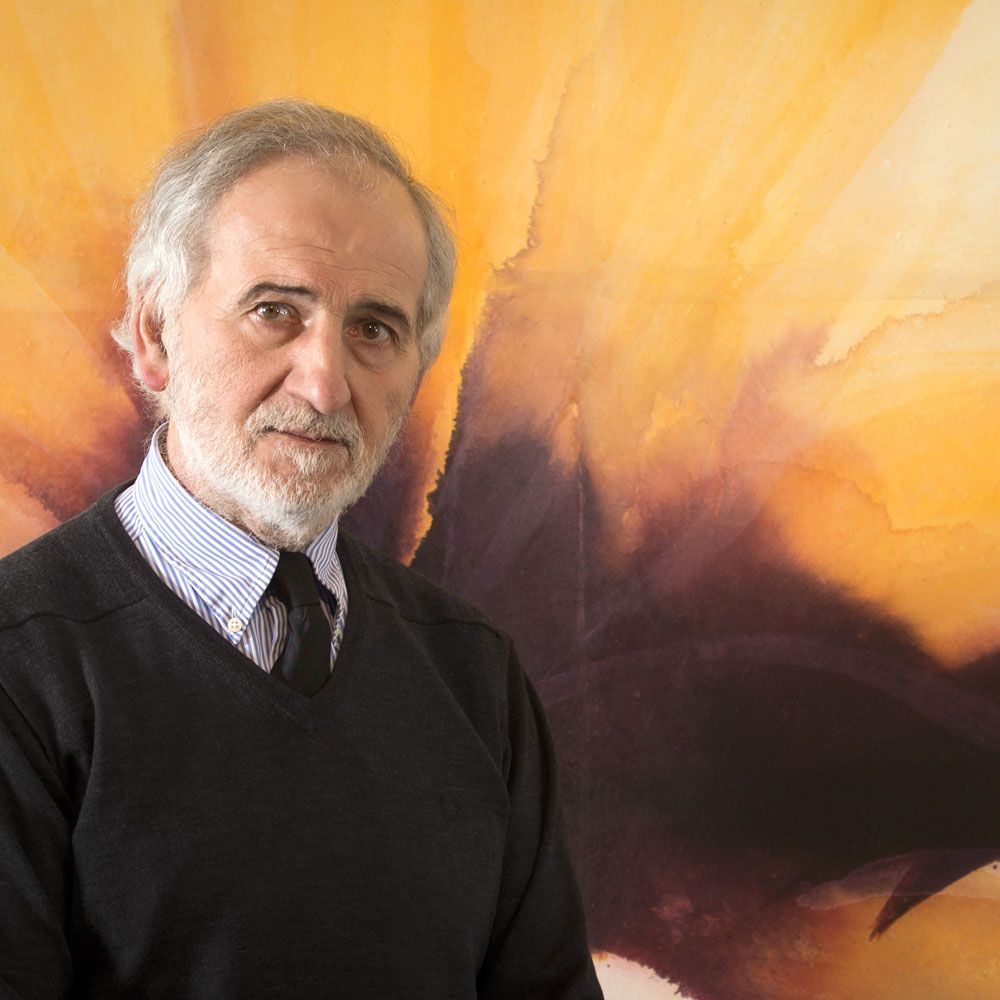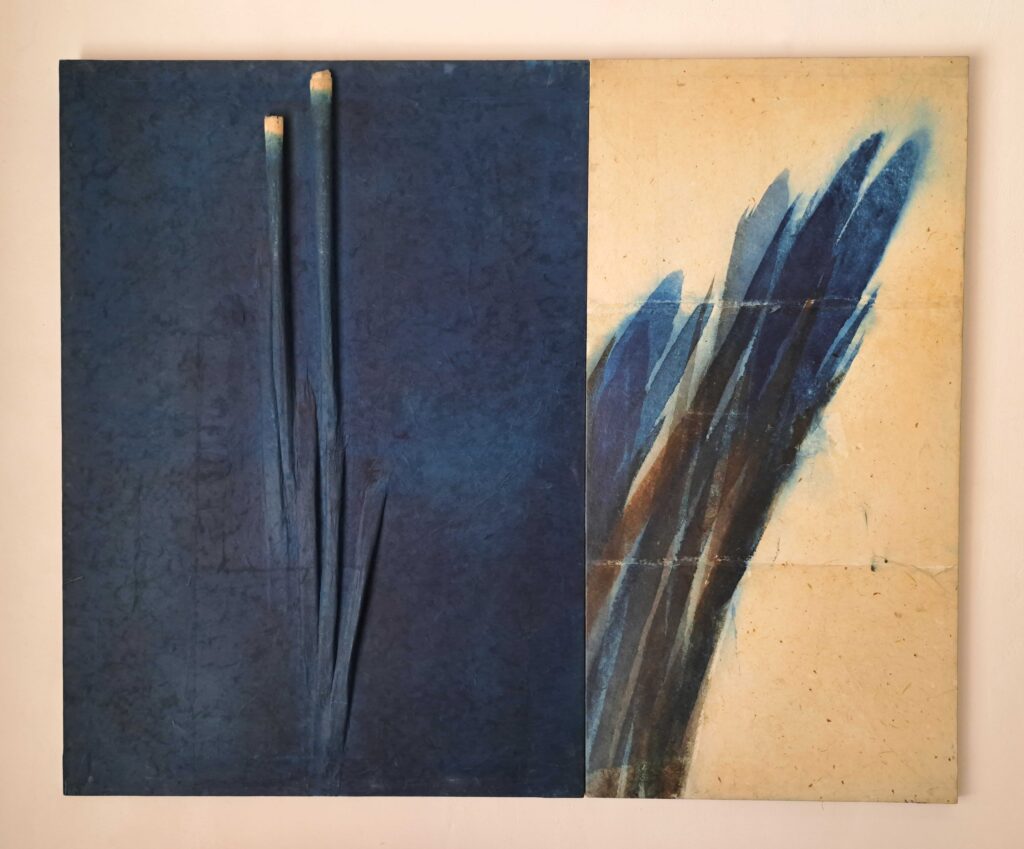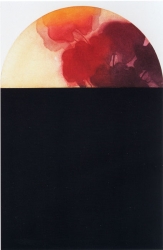Davide Benati

Davide Benati was born in 1949 in Reggio Emilia and lives between Modena and Milan, where he teaches at the Brera Academy. Since his first solo exhibitions in 1980 at the Nuovi Strumenti Gallery in Brescia and at the Studio Cannaviello in Milan, Benati’s painting has been characterized by a strong conceptual component, even though he is fascinated by the thousand nuances of narration and by a methodical choice of materials. The paper handmade in Nepal, which the artist uses as a support, has become over the years a substantial material organic to his painting.
The materials are also the memory of cultures, peoples and their narratives from which Benati draws, translating them into his own language. Thus one of his books from 1991 unusually opens with a tribute to the Nepalese, Portuguese and Irish. Like subtle traces, Benati’s works live on the lightness of matter and play on the appearance of signs. The essential iconography, inspired by the forms of nature, is structured through the conflict between sweet and graceful or sweet and angular lines. The flowers and the leaves, frequent in his works, become a pure pictorial organism, whose dilated dimension exceeds the illustrative aestheticism to get lost in the impalpable charm of the surface. Several personal exhibitions have been dedicated to his work in private galleries in Italy and abroad (from Isola in Rome to Studio Marconi in Milan) and anthological exhibitions in public museums.
In 1990 he was dedicated a personal room in the Italian Pavilion of the XLIV Venice Biennale. In 1991 he exhibited in New York (Panicati Fine Arts), Milan (Verlato Gallery), Turin (Alberto Peola). In 1992 the Civic Museums of Reggio Emilia dedicate a major exhibition (catalog by Luciano Caramel). Personal exhibitions followed in Paris (De Tugny-Lamarre gallery, 1993), Rome (L’Isola gallery, 1994), Bologna (Maggiore gallery, 1994), Turin (Alberto Peola gallery, 1995). In recent years he has had numerous personal exhibitions: in 1996 in Trento (L’Isola gallery), in 1997 in Turin and Bologna (at the Peola and Maggiore galleries); in 1998 at the “Arte 92” gallery in Milan and in 1999 in Maulbronn, Germany, and then in Portugal, at the Gulbenkian in Lisbon. In 2000 Davide Benati exhibited at the Maison du Livre in Aix en Provence and at the Gam in Montecarlo; in 2001 at the Patrizia Poggi Gallery in Ravenna and the Alberto Peola Gallery in Turin. In 2003 personal exhibition at Palazzo Magnani in Reggio Emilia with a catalog edited by Sandro Parmigiani. He returned to Bologna with a solo exhibition by Geneva Grigolo (gallery “G7”) in January 2005.
Request the paintings available in the Gallery
Painting works

Davide Benati
Notturno con lanterne, 1990
Oil, watercolor and paper mache on canvas, 140 x 170 cm
Graphic works

Pala del silenzio, 1998
Acquaforte acquatinta, 107×74 cm
Tiratura n. 90 arabi
Editore Santa Chiara , Urbino
Conceptual Naturalism
Born in Reggio Emilia in 1949, Davide Benati was a student and then a teacher of painting at the Academy of Fine Arts of Brera and later of anatomy in Bologna; his work has been traced back to the continental artistic current “Nuova Figurazione”, an alternative, in the 1960s-1980s, to the conceptualism of Arte Povera, and of which the Italian Transavanguardia is a close expression; in reality, Benati is an undefinable artist, particularly in the post-modernity to which he was wanted to be tangent at the beginning of the 1980s, and who, with his “iconic eventualities” (Enrico Crispolti), belongs, in my opinion, to what I interpret as conceptual naturalism 6, that is, a koine that, on the basis of a hypothesis of current development that differs from the last Archangelian naturalism, avails itself of conceptual experience, taking place in a modern synesthesia, of a syntactic kind, which unites Benati’s research to that of Pinuccia Bernardoni, to the more recent one of Nanni Menetti, to the Arpe d’erba (Grass Harps) of Germano Sartelli and to the cycle of the Albero della russine (Rust Tree) of Maurizio Bottarelli, just to name a few in the Emilia region: artists who, starting from a datum of nature, abstract it and rework it theoretically into new forms and meanings, maintaining the datum of nature as a symbolic mental code and syntactic pattern within works that open to renewed semantics.
Naturalistic, organic forms which, in the case of Benati’s painting, take on renewed meaning and significance through a heartfelt holistic sense, oriental and therefore beloved by the artist, of movement and matter which, due to the osmotic interdependence between the elements that make up all that exists, air, water, fire, space, earth, touches on the ancient Indian texts of the Vedas and ancient Chinese thought, still unaware of the existence of atoms, and arrives at an abstract reinterpretation of Claude Monet’s Water Lilies. As Francesco Poli puts it, “flowers and leaves become a pure pictorial organism, a microcosm inhabited by delicate and wonderful chromatic games, by ample tonal drafts, by barely shadowed spatiality, in which the spectator’s gaze is invited to enter in order to lose itself in the impalpable enchantment of the surface”, which acquires depth and atmosphere in the drafting of repeated superimpositions of lyrical chromatic transparencies on oriental paper glued on canvas.
The beginning
The end of the sixties codified a common denominator for the majority of art with the refusal of the artistic object: in 1967 we witnessed the real crisis of the art
In 1967 we witnessed the real crisis of art as understood until now and the overflow of the work into the environment, always with a variety of characteristics and “attitudes” that fluently oscillated between the instances of the two opposites of minimal art and funk art filtered from the United States, England, Holland and France and that were reworked in Italy, with absolute originality, in the Arte Povera, born between 1967 and 1969 in Turin, and theorized by Germano Celant: a new attempt to reset for an art with radical ambitions of new existential experimentation through the use of technical materials of common use, waste or natural,sometimes combined with more traditional media and mysterious magical evocations.
At the same time, American minimalist painting, which drew its sap from its precursor Yves Klein, reverberated in Europe in the analytical-reductive conceptual painting of the French groups BMPT and Support-surface, which in 1967 presented works at the Salon de la Jeune Peinture in Paris at the “zero degree of painting” and in which Benati recognizes the influences received from Luis Cane and Noel Dolla, even if, in my opinion, some influences from the German painting of Peter Rocher and Blinky Palermo have filtered into the art of the Reggio Emilia artist’s beginnings.
A Central European artist, then, who exhibited in Modena, in 1977, a series of paintings made on hand-made paper and who introduced with these words, leaking, in filigree, the pleasant seduction, almost physical, of the material: “paper as an original surface charged with connotations; its edges are frayed as an allusion and the recovery of watercolor as color and matter that enters the paper slowly to explore its interior or that, in transparency, highlights its margin, assembly, structure, the final trace as a ‘parallel history’ to my hand.”
At the end of the seventies we witnessed a duplicity of phenomena of opposing force: if on the one hand anthropological art opened up new avant-garde horizons by meditating on objective and behavioral signs, such as Luigi Ontani’s masks, on the other hand a closure in the models of art history led to a crisis in the history of art.
of art led to a crisis in the values of ideology and to a refuge in the past that opened the era of postmodernity.
And while Achille Bonito Oliva was inaugurating in Ravenna the exhibition Italiana. Nuova Immagine, in which he proposed the “estranged figuration” (Crispolti) expressed by the newborn Transavanguardia, as well as the researches of the second Roman school in balance between abstraction and vague iconicity, Giorgio Cortenova ordered the exhibition L’estetico e il selvaggio (The Aesthetic and the Savage) in 1979 at the Galleria Civica in Modena, in which Benati participated, confronting the multiplicity of currents of the moment, from anthropological to conceptualism, from object to sign painting, from the neo-expressionism of the Transavanguardia to anachronistic quotationism, marking with originality the return of the sign sensitivity of painting and its spatiality.
